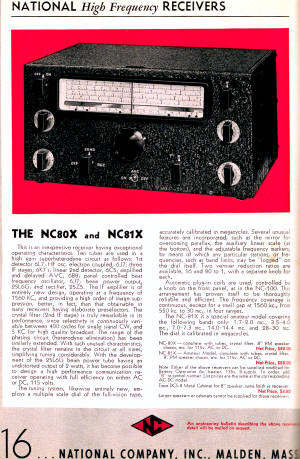September 1937 QST |
 Table
of Contents Table
of Contents
Wax nostalgic about and learn from the history of early electronics. See articles
from
QST, published December 1915 - present (visit ARRL
for info). All copyrights hereby acknowledged.
|
The National Company of Cambridge, Massachusetts,
was one of the first large distributors of electronics components and appliances.
Believe it or not, National began life as the National Toy Company. Thanks to the
efforts of Mr.
James Millen, W1HRX, in designing and marketing high quality radio products,
the company evolved into a favorite source by both amateur radio operators and casual
listeners of shortwave radios. The NC80X covered the commercial broadcast band and
a couple shortwave bands, whereas the NC81X covered only multiple shortwave bands
for amateur radio use. This full-page advertisement appeared in a 1937 issue of
QST magazine.
National Company Catalog & NC80X / NC81X Receiver Advertisement
 As usual at this time of
year, a new National catalog is ready. Also, as usual, you will want a copy for
it is free for the asking, and easily the season's best bargain. You will find several
noteworthy new products between its covers, among them the new NC-80X and NC-81X.
These two new receivers belong to the SW-3-FB-7 tradition, for they are thrifty,
reliable, and capable. Also they are a lot of fun to operate for reasons that will
be evident when you get your hands on one. You will find a page from the new catalog
describing them on the other side of this sheet. There are other new products, too,
such at the multiple crystal holder; to say nothing of old products revamped, such
as the receiving type sockets which have new conveniences and adaptability. And
of course, there are the old reliables like the R-100 choke and the TM condensers,
which are as well known as the trade-mark they carry.
Your dealer has a copy for you.
National High Frequency Receivers
 The NC80X and the NC81X The NC80X and the NC81X
This is an inexpensive receiver having exceptional operating characteristics.
Ten tubes are used in a high gain superheterodyne circuit as follows: 1st detector
6L7; HF osc. electron coupled, 6J7; three IF stages, 6K7's; linear 2nd detector,
6C5; amplified and delayed AVC, 6B8; panel controlled beat frequency oscillator,
6J7; beam power output, 25L6G; and rectifier, 25Z5. The IF amplifier is of entirely
new design, operating at a frequency of 1560
 KC, and providing a high order of image
suppression, better, in fact, than that obtainable in many receivers having elaborate
preselectors. The crystal filter (2nd IF stage) is truly remarkable in its performance,
since selectivity is continuously variable between 400 cycles for single signal
CW, and 5 KC for high quality broadcast. The range of the phasing circuit (heterodyne
elimination) has been similarly extended. With such unusual characteristics, the
crystal filter remains in the circuit at all times, simplifying tuning considerably.
With the development of the 25L6G beam power tube having an undistorted output of
2 watts, it has become possible to design a high performance communication receiver
operating with full efficiency on either AC or DC, 115 volts. KC, and providing a high order of image
suppression, better, in fact, than that obtainable in many receivers having elaborate
preselectors. The crystal filter (2nd IF stage) is truly remarkable in its performance,
since selectivity is continuously variable between 400 cycles for single signal
CW, and 5 KC for high quality broadcast. The range of the phasing circuit (heterodyne
elimination) has been similarly extended. With such unusual characteristics, the
crystal filter remains in the circuit at all times, simplifying tuning considerably.
With the development of the 25L6G beam power tube having an undistorted output of
2 watts, it has become possible to design a high performance communication receiver
operating with full efficiency on either AC or DC, 115 volts.
The tuning system, likewise entirely new, employs a multiple scale dial of the
full-vision type, accurately calibrated in megacycles. Several unusual features
are incorporated, such as the mirror for overcoming parallax, the auxiliary linear
scale (at the bottom), and the adjustable frequency markers, by means of which any
particular stations, or frequencies, such as band limits, may be "logged" on the
dial itself. Two vernier reduction ratios are available, 16 and 80 to 1, with a
separate knob for each.
Automatic plug-in coils are used, controlled by a knob on the front panel, as
in the NC-100. This arrangement has proven itself to be thoroughly reliable and
efficient. The frequency coverage is continuous, except for a small gap at 1560
kc., from 550 kc. to 30 mc., in four ranges.
The NC-81X is a special amateur model covering the following bands only: 1.7-2.0
mc., 3.5-4.0 mc., 7.0-7.3 mc., 14.0-14.4 mc. and 28-30 mc. The dial is calibrated
in megacycles.
Here are all the National Company advertisements I have:
- National's Company:
Merry Christmas and Happy New Year, January 1941
- National Company:
Noise Limiters, September 1950
- National Company: Modulators, April
1942
- National Company: Switches,
May 1939
- National Company: TMS Condenser, March 1939
- National Company: TVI, October
1953
- National Company:
Amateur Radio Activity, December 1952
- National Company: HRO-50
Receiver, May 1951
- National Company:
Noise Limiters, September 1950
- National
Company: Modulation, October 1947
- National Company:
Merry Christmas and Happy New Year, January 1942
- National Company:
Merry Christmas and Happy New Year, January 1941
- National Company: Switches,
May 1939
- National Company: AC Power Strip,
April 1939
- National Company: TMS Condenser,
March 1939
- National Company Catalog: NC80X
/ NC81X Receiver Advertisement, September 1937
- National Company:
IF Circuits, September 1935
Posted June 29, 2021
(updated from original post on 1/10/2014)
|












